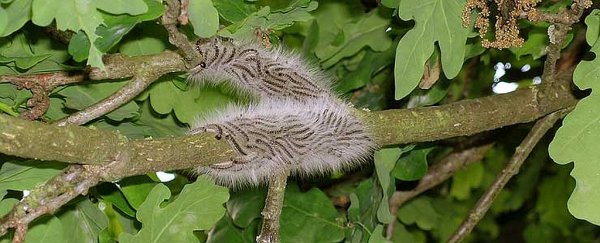If you thought Australia was bad, you probably don't want to be in London right now.
The capital of England and the UK is being plagued by an outbreak of toxic moth caterpillars that can cause itching, rashes, sore throats, eye problems and even anaphylaxis.
They're the larvae of the oak processionary moth, which live in and feed off oak trees, and they're infesting the woodlands of south-east England, the UK Forestry Commission has warned.
The suburbs of Greater London are primarily affected, including Croydon, Richmond, Bromley, Richmond and Twickenham.
The caterpillars don't look like much, but they are deeply unpleasant.
They swarm in large numbers, proceed in a nose-to-tail line up and down trees, and full-grown caterpillars can be covered in up to 63,000 poisonous hairs, or setae.
This means that if you touch them, you're in for a bad time (no known deaths have occurred from the caterpillars, but it's still pretty nasty), but it gets worse.
These setae break of very easily, and can become airborne - coming into contact with unsuspecting humans.
"The caterpillars' thousands of tiny hairs contain an urticating, or irritating, substance called thaumetopoein," the Forestry Commission wrote on its website.
"Contact with the hairs can cause itching skin rashes and, less commonly, sore throats, breathing difficulties and eye problems. This can happen if people or animals touch the caterpillars or their nests, or if the hairs are blown into contact by the wind. The caterpillars can also shed the hairs as a defence mechanism, and lots of hairs are left in the nests."
Pets are also affected, and the trees don't fare very well either. Large populations can completely strip an oak tree bare of its leaves, leaving in vulnerable to pests, diseases and environmental stresses.
 Oak processionary caterpillars on a tree, and feeding damage. (Jörg-Peter Wagner/CC-BY-SA-2.5)
Oak processionary caterpillars on a tree, and feeding damage. (Jörg-Peter Wagner/CC-BY-SA-2.5)
Oak processionary moths made their first appearance in London in 2006, and it's not clear how they got there.
They're native to central and southern Europe; the forestry commission believes they have in the past arrived on young imported oak trees on which the moths have laid their eggs, hatching in April and May after the trees are already planted.
Because the moths' natural predators are not present in the UK, the moths run rampant; and, in spite of Forestry Commission efforts to halt the epidemic, outbreaks have recurred in many years since 2006.
This is partly because the moths' eggs are small and hard to find, so it's impractical to search all but the smallest of imported trees.
The Forestry Commission is in the process of treating all known infestations with biopesticides, and will continue doing so until May or June, when the caterpillars will be too big for the treatment to be effective.
In the meantime, the Forestry Commission warns residents not to approach or touch the caterpillars, not to allow children to approach or touch the caterpillars and certainly not to try to take care of any nests themselves, instead calling a qualified pest control expert.
